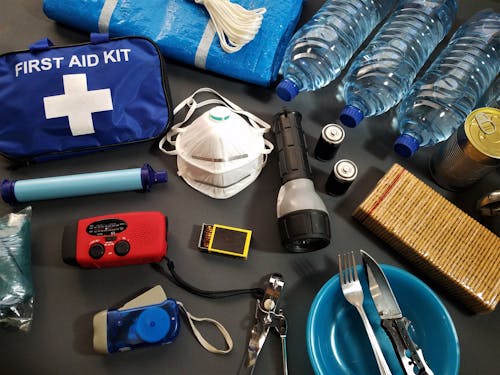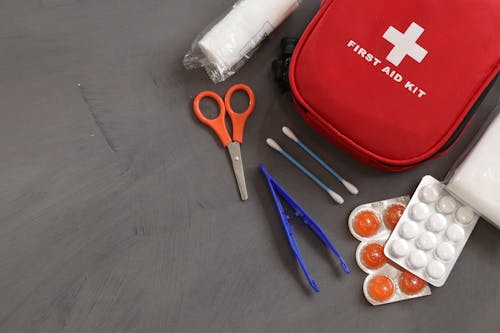Everyday first aid kit
Are you still not sure what necessary medical equipment to carry with you in everyday civilian life? An article written by a former military doctor who worked in special forces will help you. He will show the contents of his own first aid kits, which he carries with him, keeps in the car and takes to the shooting range.

Personal first aid kit
" My absolute minimum: a tourniquet (or, if it is inconvenient to carry it with you, improvised materials from which you can build something similar). I advise you to always carry a tourniquet in your first aid kit, because even in ordinary city life an ambulance or a doctor sometimes you have to wait too long, and situations in which a tourniquet is needed are usually very critical in terms of the time of assistance.
Here is a list of what I carry with me in my daily life:
- Turnstile
- Bandage
- Small compression bandage
- Patch for penetrating chest injuries with decompression needle
- Nasopharyngeal airway with surgical lubrication
You can also add:
- Flashlight (optional, if you need a light source brighter than the flashlight built into your phone)
- External battery
- Pistol and ammo
- Knife
- Banknotes and coins

In fact, you can put in the first aid kit everything that will make your life easier and prepare you for unforeseen situations. But I would not advise taking too many things with you and filling the first-aid kit to an unbearable state. You can carry these essentials either in an ankle bag or a fanny pack (either fathers of the family or special forces wear these, so try to look more like a father of the family). However, the best and most convenient option would be a backpack. "
Everyday car first aid kit
"The driver never knows what situation on the road he can get into. You can get into an accident, get stuck in traffic, find yourself in the middle of a strike, and so on. However, the driver always needs to be responsible behind the wheel, which means you must be prepared for all sorts of situations on the road that require emergency medical attention. But, at the same time, don't stuff your car with all sorts of medical equipment to the point where you won't have anywhere to sit. Don't carry a whole hospital around with you, waiting to see what happens. Don't become paranoid, always trying to be prepared for any eventuality. Do not overload the car if you live in a peaceful country where there are no military conflicts and where it is possible to quickly call an ambulance.
Here is my list of necessary medical equipment for the machine:
- Tourniquet Trauma Care Basic Kit
- First Aid Kit
- Empty gas can (if you run out of gas somewhere in the middle of nowhere, you can fully enjoy the feeling of shame while walking with it to the nearest gas station)
- Water bottles
- Scotch
- Spare clothes (to prevent hypothermia)
- Sleeping bag
- Scissors
- Multitool
- Head Torch
- light markers
- Reflective vest
You can buy these items at best prices in USA here:
https://www.chartertactical.com/
Everyday shooting range first aid kit
" As a responsible citizen, you must be prepared for incidents that can happen on the shooting range. Accidents do happen quite often on shooting ranges and shooting ranges. Remember how many times you have seen people who are better off shooting with a toy gun and not with a real gun. Such Comrades often shoot themselves in the foot or leg.They are simply irresponsible with weapons and do not take what is happening seriously.However, this is not a game and a weapon is not a toy.Accordingly, I recommend always having a first aid kit on hand at the shooting range.There are various incidents at the shooting range, so in your first aid kit should have the means to provide all kinds of medical care in completely different scenarios. "
Here is my list of shooting range essentials.
Trauma First Aid Kit:
- Turnstile
- Compression bandage
- Bandage
- Nasopharyngeal airway with surgical lubrication
- Patch for penetrating chest injuries
- A blanket
All kinds of additional items depending on your needs and the legislation of your country:
- Lung decompression needle
- EpiPen (automatic syringe with adrenaline)
- ACE dressings
- And also everything that you need specifically for you (my kit has everything I need, but you may have a different combination of items).
"Emergency" everyday first aid kit
" Many people ask me, what's in your "emergency" first aid kit? It contains items that will help you in case of painful injuries and embarrassing situations that, as a rule, people get into due to their own stupidity.
Here is my list:
- A set of quality patches for corns
- Rubbing alcohol (for sterilizing wounds and hands)
- Quality bandages (for dressing wounds)
- Painkillers, antipyretics, antihistamines and antivirals
- Sunscreen
- Electrolyte solution (required for dehydration)
- A bar of chocolate (a source of energy and pleasant emotions).
All this is useful to have on hand, but do not worry if something is missing in your "emergency" first aid kit - you will survive it. "


